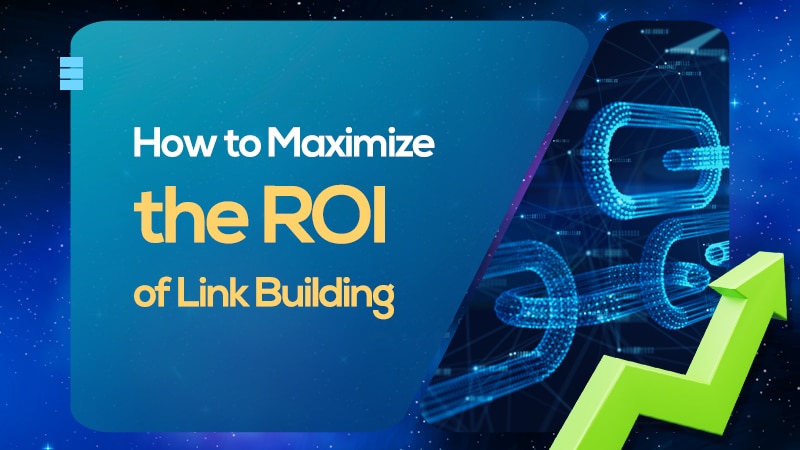How to calculate link building ROI and justify your SEO investment by Stellar SEO


Link building is often 40% of an SEO budget – sometimes more in competitive industries. But here’s the problem: most companies aren’t calculating ROI before building links. That’s a fast way to burn through your budget without knowing what you’re getting in return.
If you spend $5,000, $10,000, or even $50,000 a month on link building, you should know what kind of return to expect.
This guide will show you how to calculate link building ROI before sending a single outreach email. We’ll cover how to assess a page’s revenue potential, estimate the cost of link building, and determine whether the investment pays off.
You’ll know exactly how to forecast ROI, avoid overspending, and prioritize the pages worth investing in.
But first, a little about me.
I’m Travis Bliffen, CEO of Stellar SEO – an Inc. 5000-ranked link building agency. Since 2012, we’ve built 25,000+ backlinks in over 100 industries and helped clients drive millions in revenue through search traffic.
After 13 years in SEO, I’ve seen what works and what doesn’t, and I’ve spoken to many companies that learned the hard way after wasting money on low-quality link campaigns.
This guide will help you avoid that. If you’re serious about results, effective link building starts with ROI modeling, whether you are doing it for your brand or using a white label link building service to fulfill your agency’s needs.
Why page value comes first in link building strategy
Before you consider how many links a page needs, you have to determine whether it’s worth building links in the first place. A solid ROI starts with a page that has real revenue potential.
Start by estimating the monthly search volume for your target keywords using tools like Ahrefs or Semrush. Then, apply an estimated click-through rate (CTR) based on where you expect the page to rank. Finally, multiply your estimated traffic by your conversion rate and the value of each lead or sale.
For example:
- A service page ranking in the Top 3 could drive 1,000 monthly visits.
- At a 3% conversion rate and $500 per lead, that’s $15,000 in potential monthly revenue.
That’s the foundation. If the revenue isn’t there, no number of backlinks will make it worth the investment.
Key metrics to determine link competitiveness
Once you’ve determined a page’s earning potential, it’s time to examine the competition. This will help you determine how many high-quality backlinks you’ll need.
Focus on these key metrics:
- Number of referring domains linking to top-ranking pages.
- Domain Authority (Moz), Domain Rating (Ahrefs), or Trust Flow (Majestic).
- Relevance of linking domains to your industry.
- Variety and natural use of anchor text.
Look at the top 3 to 5 ranking competitors. You can estimate how many links you’ll need and determine if your content is as good or better.
How many links do you need?
Like finding the best link building service, there’s no one-size-fits-all answer. It depends on your current authority, how strong your competitors are, and the quality of your content. But with the data you’ve gathered, you can come up with a solid estimate.
For example:
- If the top page has 50 links and you have 10, you might need 30 to 40 strong links to compete.
- If your domain is more authoritative, you may need fewer.
- If your content is weak or new, you’ll probably need more.
This data-backed estimate is more helpful than someone promising “10 links a month” without context.
Building links strategically vs. tactically
Chasing quick wins or buying cheap placements might work for a while, but real ROI comes from strategy. That means choosing the right pages to promote, using anchors that match search intent, and using links from relevant, trusted websites.
When your link strategy supports your business goals, it becomes a growth tool rather than just another SEO checkbox.
Breaking down link building costs by tier
Not all backlinks are created equal, and they don’t all cost the same.
Here’s a simple breakdown by link tier:
- Tier 1: DA/DR 70 and up, niche relevant, editorial placements – $750 to $1,250+
- Tier 2: DA/DR 50 to 69, moderately relevant – $400 to $600
- Tier 3: DA/DR 30 to 49, less authority but relevant – $250 to $399
Most campaigns use a mix. You can estimate your total cost based on how many links you need.
Let’s say you need 25 links:
- 5 Tier 1 = $4,000
- 10 Tier 2 = $3,500
- 10 Tier 3 = $3,000
Total Investment: $10,500
Why high quality backlinks matter in ROI modeling
Calculating ROI is not about how many links your competitors have – it’s about how many valuable links they have.
If you base your link budget on raw link counts, you will overspend, chase junk, or both.
Here’s how we approach it:
- Start with the top-ranking pages for your target keywords and pull their backlink profiles using tools like Ahrefs.
- Eliminate low-value links from the analysis. That includes obvious spam, sitewide footers, irrelevant blog networks, and low-trust placements. We don’t judge quality by DR alone. Context matters. For example, a DR 20 link from a local business directory may be worth including if it’s topically and geographically relevant.
- Segment what’s left into link tiers based on strength and relevance. This gives us a realistic average cost per link and an accurate target count.
This filtering step is key. It ensures you’re only modeling ROI based on links worth replicating – links with the potential to pass authority and move rankings.
Bad links inflate your projections and waste your budget. A clean, screened link profile leads to smarter forecasting, more efficient budgeting, and a better chance of hitting your goals.
How to calculate link building ROI
Now that you’ve estimated the page’s revenue and your total link building cost, it’s time to do the math.
ROI = (Annual Page Value – Link Building Cost) / Link Building Cost
Example: If a page has $60,000 in yearly potential and you spend $10,000 on link building, your ROI is:
($60,000 – $10,000) / $10,000 = 5.0, or 500%
Link building isn’t a quick win, but with the right execution, you can break even in a few months and keep earning long after the links are live.

How to maximize the ROI of link building
Once you know the ROI potential, the next step is to increase your return without increasing your budget. Here’s how:
Conversion optimization: Turn clicks into conversions
Getting traffic is just the start. Improving your layout, CTAs, load time, and trust elements can dramatically boost the number of visitors who become leads or customers. Even a small conversion rate increase can double your ROI – no extra links required.
Content enhancements: Make pages easier to rank
You’ll need more links to compete if your content is weak or poorly structured. You can rank with fewer links and hold your position by improving your content’s depth, formatting, and relevance.
Anchor text planning: Use links more effectively
Smart anchor text helps you rank faster and avoid penalties. Mix branded, partial match, exact match, and generic anchors. Plan your link profile to look natural and stay aligned with your strategy.
Link building content strategy: Use linkable assets to support money pages
You don’t have to point to every link on a service page. Supporting content (e.g., guides, stats pages, blog posts) can attract great links and boost your main pages through internal linking. A good content strategy supports both SEO and conversions.
What to look for in a link building agency
Not every agency is built the same. If you’re spending thousands per month, make sure your link building agency:
- Creates a custom strategy for your business.
- Manually vets prospects.
- Prioritizes quality over quantity.
- Can explain the “why” behind every link they build.
At Stellar SEO, we’ve built our reputation doing this.
Common mistakes that kill ROI
Most failed campaigns don’t fail because of Google – they fail because of bad planning. Here’s what to avoid:
- Not calculating ROI before you start.
- Buying cheap, irrelevant, or low-quality links.
- Building links to pages that don’t convert.
- Working with link builders who focus on volume, not results.
If your agency can’t explain how and when your investment will pay off, it’s time to reevaluate.
The long-term value of building domain authority
When you build links, you’re strengthening your entire domain. That means:
- Future pages will rank faster with fewer links.
- Your site becomes more stable and less affected by algorithm updates.
- You can target more competitive keywords with confidence.
The longer you invest in link building efforts, the more valuable each link becomes.
Link building is a calculated investment, not a gamble
Link building doesn’t have to be a mystery. With the correct data and a smart plan, you can make confident decisions that generate strong returns.
Before starting your next campaign, ask:
- Is this page valuable enough to rank?
- How many links will it take to get there?
- What will those links cost?
- How long until I break even?
If you’re unsure how to answer those questions, that’s where we come in.
At Stellar SEO, we help brands build smart, scalable link building campaigns with ROI in mind from day one. Whether you’re spending $5,000 or $50,000 monthly, we’ll help you get more from every link – and every dollar.
Ready to build a campaign that pays for itself? Let’s talk.






Recent Comments